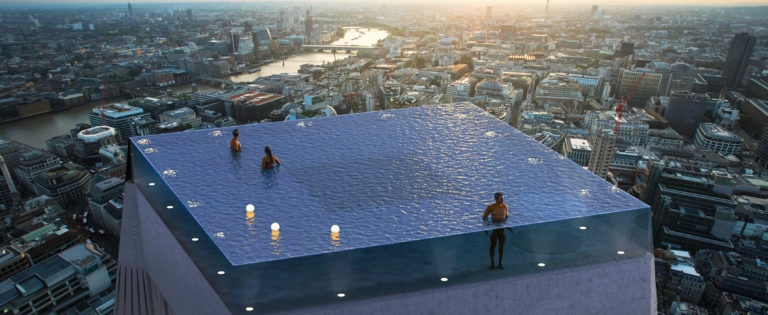In 1924, Buster Keaton approached the Life magazine film critic Robert E Sherwood, to write a script set on an under-construction New York skyscraper. In it, Keaton’s character is showing the architect’s daughter the views from the top when a strike is called, workers down tools, power is cut from the lift and the pair find themselves stranded. Like a modernist Robinson Crusoe, the plot then follows the pair trying to get attention from people in nearby buildings to no avail before building a shelter, and developing strategies to catch rainwater to drink and pigeons to eat.
It came to mind today when I saw the CGI renders of Infinity Pool, a speculative-proposal-cum-clickbait-marketing-stunt from swimming pool designer Compass Pools. The alluring images show the entire roof of an unnamed central-London tower given over to an infinity pool, with no apparent means of escape, as if the digital people are in some kind of sublime prison cell for the super rich. We are assured there is in fact a way in and out, courtesy of a “rotating spiral staircase which rises from the pool floor”, and that this is an entirely buildable proposition that includes an inbuilt anemometer to “vary the water level and access to the pool”.

The designer, Alex Kemsley, said, “the building started life as a design concept to push engineering boundaries and literally punch for the sky” and added that there has been “significant global interest” including talks with developers and a luxury hotel chain. But don’t expect to see it in the capital. Kemsley tells me that while London would be his preferred location, “since the story has broken” he has entered talks for a similar project in Dubai.
This Infinity Pool appearing in the City of London is about as likely as a pool being fitted in the restored Notre Dame Cathedral, but clickbait images such as this get huge traction – so it’s worth interrogating what they represent for a changing city.
In 2015, Redrow Homes released a promotional film for a high-rise luxury development in Docklands, quickly pulled after public disgust and mockery. The suited man who seemed to live in the aspirational apartment walked to his window, looked over London and declared: “They say nothing comes easy, but if it was easy, then it wouldn’t feel as good. To look out at the city that could have swallowed you whole, and say, ‘I did this.’ To stand with the world at your feet.”
There was something deeply dystopian about the advert, calling to mind the “discreet oligarchy of minor tycoons and entrepreneurs” who lived on the top five floors of the building in JG Ballard’s High Rise. In a foreshadowing of poor doors and private playgrounds, Ballard’s jet-set residents had their own “high-speed elevators and superior services”, and as more luxury towers with multi-million pound penthouses crop up, London is becoming two concurrent cities, where rich and poor not only fail to rub shoulders but – through the use of height as separation – don’t even see one another. We exist in what Stephen Graham called, in his recent book Vertical, an “elite takeover of the urban skies”.
Peter Cook, of the architecture firm Archigram, once said: “The skyscraper is still the stuff of heroes. Superman and Superwoman can aspire to the executive floor, or even higher. The only problem as a designer is how to make your tall box different from the rest.” As towering buildings pop up across Britain’s capital (the recently published Tall Buildings Survey suggests 541 are in the pipeline), Cook’s adage becomes more true.
Starting with the Shard’s £24.95 view across London, viewing platforms have become synonymous with the boom in tower building. Then developers saw how such a “public offer” may help smooth planning applications, witnessed with the Sky Garden public park – which is neither public nor a park – and arguably more a corporate entertainment space than anything benefiting Londoners. Every tower from Vauxhall to Docklands now seems to have some potted trees at its top, occasionally even with public benefit but usually solely as a statement offer for overpriced flats frequently sold to offshore investors.

Following this, developers saw value in topping their creations with quirky, marketable attractions. Then came the swimming pools. The Sky Pool, a transparent acrylic swimmable bridge between two luxury rooftop gardens in Nine Elms, led to equal measures of public excitement and disgust depending on your view of such technological “progress”. In this newspaper, Oliver Wainwright predicted that the Sky Pool would become a “torrent”, and Infinity Pool is the latest evidence that he may just be right.
The addiction of sticking such playful propositions higher into the clouds reached an absurd peak last year with Norman Foster’s proposed Tulip. A tower of glass and steel (and unacceptable levels of embedded carbon) with no function whatsoever other than supporting a restaurant, rotating gondolas, and a glass slide.
Buster Keaton and Robert Sherwood’s skyscraper story never got made. The pair couldn’t contrive a believable way for the characters to escape from the building that also incorporated enough of Keaton’s pratfalls. Might it be that we are in a similar situation with architectural propositions like the Infinity Pool?
guardian.co.uk © Guardian News & Media Limited 2010
Published via the Guardian News Feed plugin for WordPress.


